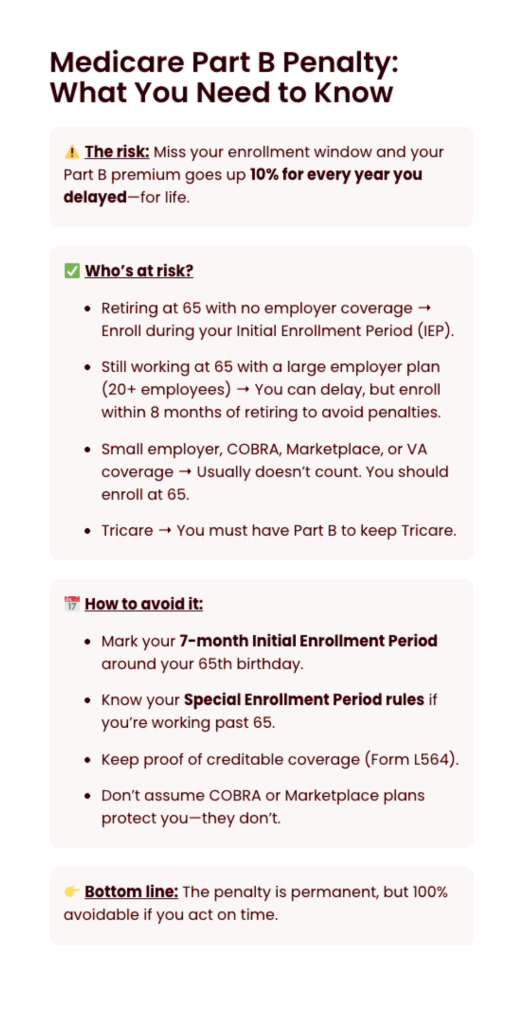Avoid a Lifetime Medicare Part B Penalty: What You Need to Know
If you’re approaching age 65, beware of Medicare’s Part B late enrollment penalty. Here’s how it works and how to make sure you never have to pay it.

Turning 65 soon? Then you’re probably getting bombarded with information about Medicare. One crucial topic that doesn’t always get enough attention is the Medicare Part B late enrollment penalty, a fee that can permanently increase your monthly premiums if you sign up for Part B too late. It might come as a surprise, but hundreds of thousands of Americans are paying this penalty for life because they missed Medicare’s deadlines. The good news is that this penalty is 100% avoidable. In this article, we’ll break down what the Part B penalty is, who is at risk, and how you can avoid ever being penalized. We’ll also share tips from official Medicare sources to help you feel confident about your timing and choices.
What Is the Part B Late Enrollment Penalty?
Medicare Part B, which covers outpatient care like doctor visits, has a specific enrollment window when you first become eligible. If you miss that window and don’t have other qualifying coverage, Medicare will charge you a late enrollment penalty once you do sign up.
So what is the penalty? In simple terms, it’s an extra 10% added to your Part B premium for each full year you delayed enrolling. And unlike a one-time fine, this surcharge stays on your premium every month for life as long as you have Part B. For example, imagine the standard Part B premium is $185/month. If you waited two years beyond your Initial Enrollment Period to join Part B, you’d pay 20% extra, about $37 more. That making your monthly premium roughly $222. This higher cost would continue indefinitely. Clearly, the stakes are high, which is why it’s so important to understand this rule upfront.
Why does this penalty exist? The idea is to encourage people to enroll in Medicare on time rather than only signing up when they get sick. By having most folks in the pool at 65, Medicare keeps the program’s costs manageable. The penalty isn’t meant to be punitive as much as it is a nudge to prevent adverse selection. However, from an individual’s perspective, it can feel like a hefty and even unfair lifelong “late fee.” Fortunately, with a little awareness, you can completely sidestep this costly charge.

Who Is at Risk for the Part B Penalty?
You might be wondering: “Does this apply to me if I plan to keep working, or have other insurance?” The Part B late enrollment penalty mostly affects people who wait too long to sign up for Part B without other creditable coverage in place. Here are the common scenarios and whether you need to worry:
1. You’re retiring at 65 or have no other health insurance
If you’re not going to have an employer health plan once you hit 65, you should enroll in Part B during your Initial Enrollment Period to avoid penalties. This Initial Enrollment Period is a 7-month window spanning the 3 months before your 65th birthday month, your birth month, and 3 months after. Missing this window without other coverage means you’re at risk for the penalty.
2. You’re still working at 65 with employer coverage
Good news! Many people in this situation can delay Part B without a penalty, as long as their employer coverage qualifies. If your health insurance comes from a current job of yours or your spouse’s at a company with 20 or more employees, Medicare considers that coverage primary. You can wait to enroll in Part B, and when you retire or leave that job-based plan, you’ll get an 8-month Special Enrollment Period to sign up for Part B with no late fee.
Key tip: Always confirm with your employer’s benefits office that your plan is creditable for Medicare Part B. It’s wise to get this in writing. Also, once you do stop work or lose that insurance, mark the date – if you miss that 8-month post-employment window, the penalty clock starts.
3. Your insurance is from a small employer or is individual coverage
If your plan is through a company with fewer than 20 employees, or you have insurance you bought on your own like an ACA Marketplace plan or COBRA, Medicare generally expects you to enroll in Part B at 65. These types of coverage do not shield you from the Part B penalty. For instance, some people mistakenly think they can continue their COBRA coverage for 18 months after retiring and sign up for Medicare later. In reality, COBRA does not extend your Medicare deadline. Medicare warns not to wait until COBRA ends, because you won’t get a Special Enrollment Period for it. The same goes for marketplace/private plans: once you’re 65, those are not considered qualifying coverage to defer Medicare. So if you fall in this bucket, plan to get Part B when you turn 65 to avoid penalties.
4. You have Veterans Affairs (VA) or Tricare coverage
Federal plans like VA health care or Tricare for military retirees have their own rules. VA coverage doesn’t count as creditable medical coverage for delaying Part B. If you rely solely on VA health benefits, you should still enroll in Part B on time to avoid penalties. You can use both VA and Medicare together. Tricare, on the other hand, generally requires enrollment in Part B by age 65 to maintain Tricare benefits. In short, always double-check the coordination rules for any non-Medicare coverage you have.
In summary, the people most at risk for the Part B penalty are those without an active large employer health plan at 65 who don’t sign up during their initial window. If you’re unsure which category you fall into, it’s crucial to find out before your 65th birthday. As Medicare’s official guidance says, sign up during your Initial Enrollment Period unless you know for sure that you have other coverage that lets you delay. Being proactive now can save you a lifetime of higher premiums.
How Can You Avoid the Part B Penalty?
Thankfully, avoiding this penalty is straightforward once you know the rules. Here are the steps to make sure you’re in the clear:
1. Mark your Initial Enrollment Period (IEP)
This 7-month window around your 65th birthday is your primary opportunity to sign up for Medicare Parts A and B. If you enroll in Part B during this time, you will not incur any late penalty. For most people, it’s wise to sign up as early as possible, especially during the 3 months before you turn 65, so that your Medicare coverage starts right when you need it. Signing up late in your IEP can sometimes delay your Part B start date, so earlier is better.
- If working past 65, understand Special Enrollment Periods (SEP): As discussed, if you’ll continue to be covered by an employer’s health plan after 65, you likely qualify for a Special Enrollment Period once that employment or coverage ends. This SEP lasts 8 months from when you leave the job or lose employer insurance, and during this time you can enroll in Part B without penalty. Importantly, this SEP exists only for current employer coverage. There is no Special Enrollment Period for retiree insurance, COBRA, or individual plans when you turn 65, which is why you must fall back to your IEP in those cases. Plan ahead: as soon as you know your retirement date, set a reminder to enroll in Medicare before or as soon as that 8-month window begins. Don’t wait until the last minute.
- Double-check any non-standard situations: Perhaps you’re covered under a union plan, or you have a Health Savings Account (HSA) with your employer insurance. These situations can have specific implications for example, you should stop HSA contributions about 6 months before enrolling in Medicare to avoid tax issues. It’s worth reviewing your situation with an expert to ensure nothing falls through the cracks. The main point is to identify any reason you might be thinking of delaying Part B and verify if it’s valid. When in doubt, err on the side of enrolling in Part B at 65 if possible. It’s better to have Part B even if it overlaps slightly with other coverage than to accidentally trigger a lifelong penalty.
- Keep records of creditable coverage: If you do delay Part B due to employer coverage, make sure to keep documentation. There’s a CMS L564 form that your employer can fill out to prove you had coverage while working. This form will be submitted when you sign up for Part B during your Special Enrollment Period to ensure Medicare knows you were covered and thus exempt from the penalty. Having this paperwork ready will make your enrollment process smoother.
- Don’t hesitate to seek guidance: Medicare’s rules can feel confusing, especially when you’re juggling retirement decisions, employer benefits, and so on. The stakes are high, but you don’t have to figure it all out alone. Consider talking to a licensed Medicare advisor if you have questions about your timing. As an example, I specialize in helping people navigate these Medicare deadlines and we stay up-to-date with the latest rules. Sometimes a brief conversation can clarify your situation and give you peace of mind that you’re on the right track.
By taking these steps, you can ensure you never pay a Part B late enrollment penalty. It boils down to knowing when you need to enroll and acting within the required timeframe. A little preparation now will protect your wallet for years to come.
I’m here to help! Schedule your free call today
Take the next step toward a stress-free Medicare experience. I’m here to help you make sense of Medicare, so you can move forward to this new chapter with peace of mind and confidence in your health coverage.
Call me at (563) 380-7506.